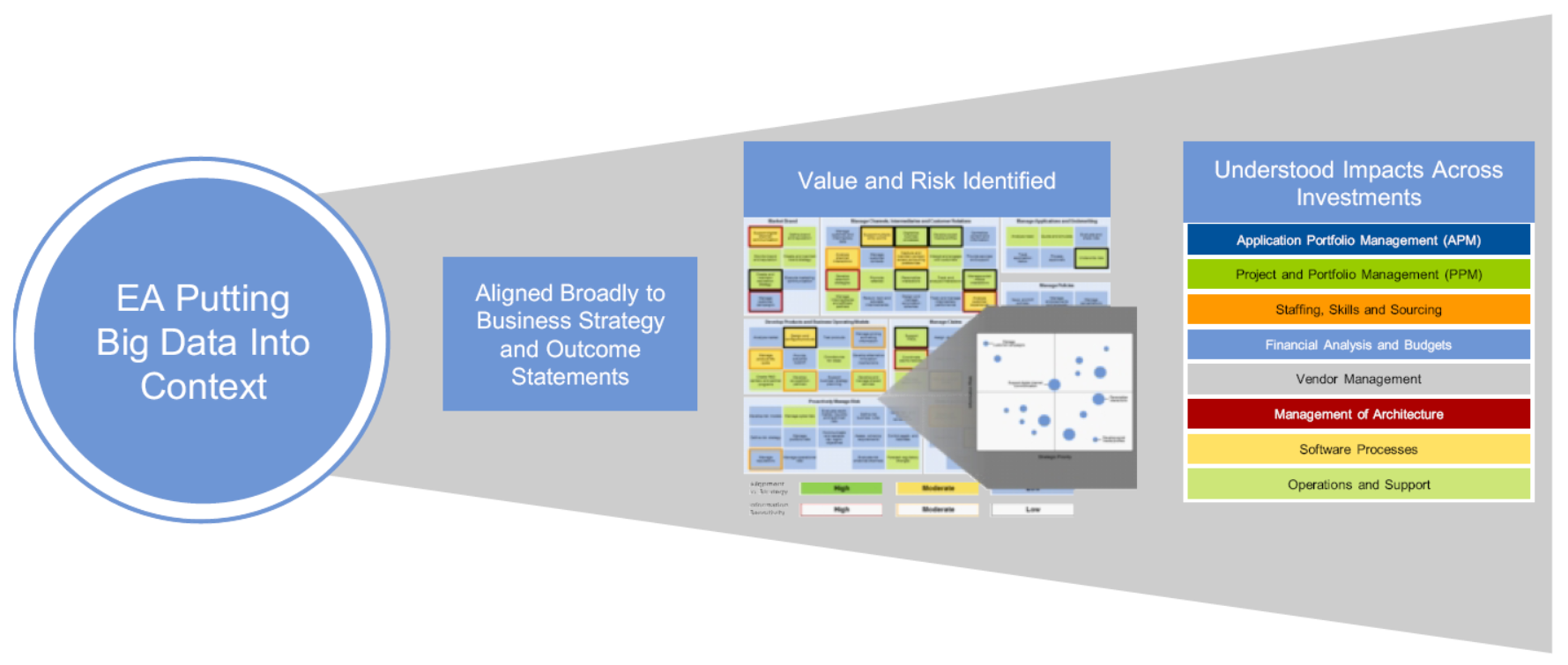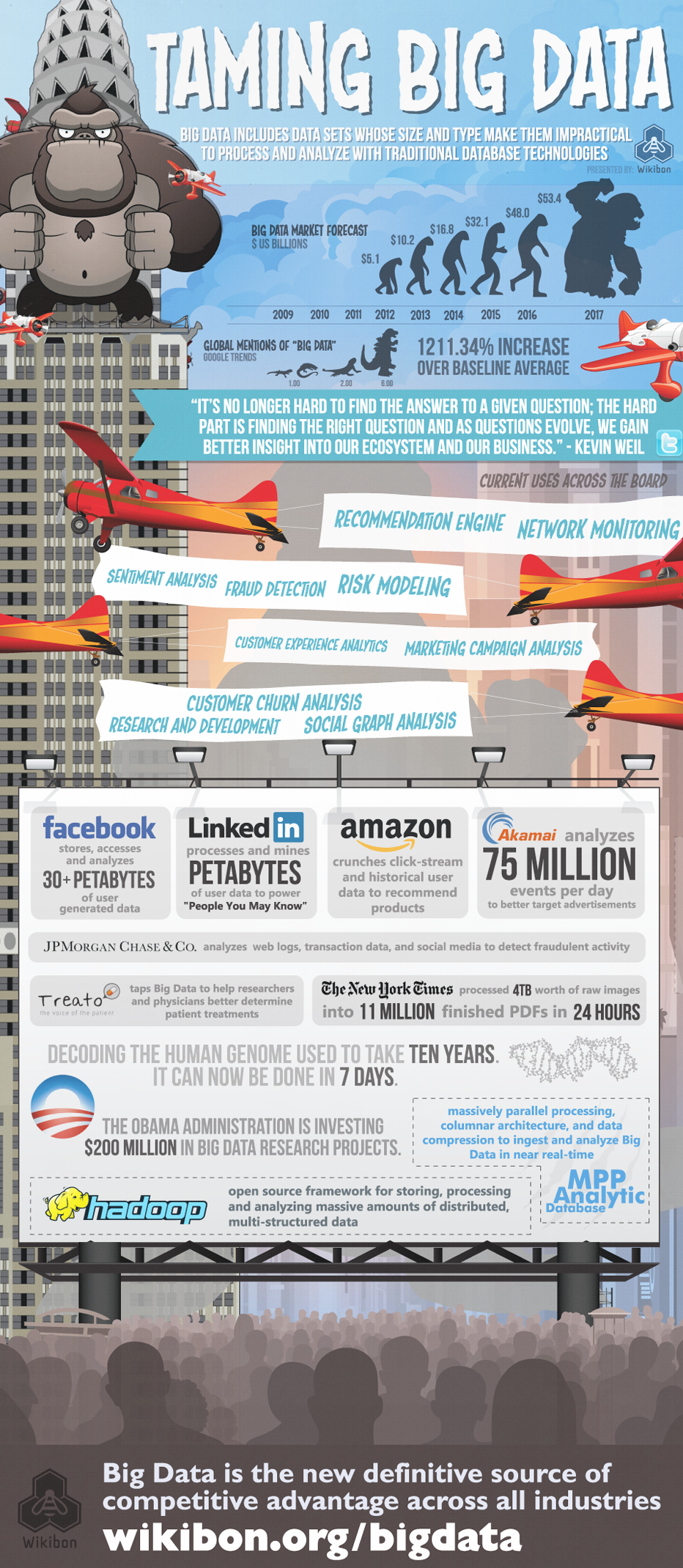The Enterprise Data Architecture, Part 2
So we know that Big data is a big problem. What can we do about it and what can we do with it?
First of all, we need to have an understanding of the content of the big data and how we process this information. Gandomi & Haider (2015) state that “the over all process of extracting insights from big data can be broken down into five stages. These five stages form the two main sub-processes: data management and analytics. Data management involves processes and supporting technologies to acquire and store data and to prepare and retrieve it for analysis. Analytics, on the other hand, refers to techniques used to analyze and acquire intelligence from big data.”
Image source: Gandomi & Haider, 2015
Once we have a better understanding of the how to process Big Data, how can we efficiently leverage the information we gain?
The growth of data metrics over time in both quantity and quality is nothing new. Even in the 80s and 90s, articles were published regarding the exponential growth of data and the challenges caused by this growth (Press, 2013). The challenge that has been continually fought in all those years has been to make the available data meaningful. Big data, as we have defined it, provides many opportunities for organizations through “improved operational excellence, a better understanding of customer relations, improved risk management and new ways to drive business innovation. The business value is clear” (Buytendijk & Oestreich, 2016). Yet, investment in big data tools and initiatives are slow to materialize.
Organizations can incorporate big data initiatives into their existing business process components and artifacts. This will help establish big data as part of their Enterprise Architecture Implementation Plan and incorporate these new business strategies into the future architecture. Educating business leaders and stakeholders as to the benefits of big data initiatives will help overcome any concerns they may have (Albright, Miller & Velumani, 2016). Back in 2013, Gartner conducted a study on Big Data which showed that many leading organizations had already adopted big data initiatives to various degrees, and were starting to use the results in both innovation initiatives as well as sources of business strategy. Included in their results from that study, they found that “42% of them are developing new products and business models, while 23% are monetizing their information directly” (Walker, 2014).
This is where Enterprise Architecture comes into play. EA is uniquely equipped, with it’s holistic view of strategy, business and technology, to not only create a strategic plan to address the potential big data opportunities, but to create a road map which positions organizations to improve operations, enable growth, and foster innovation. “Organizations that leverage EA in their big data initiatives are able to identify strategic business goals and priorities, reduce risk and maximize business value” (Walker, 2014).
Image source: Walker, 2014
Through the various efforts of EA, new technologies and new approaches to processing, storing and analyzing Big Data, organizations are gradually finding ways to uncover valuable insights. Obviously, leading the charge are leaders such as Facebook, LinkedIn and Amazon, but many other companies have joined the effort as well. “From marketing campaign analysis and social graph analysis to network monitoring, fraud detection and risk modeling, there’s unquestionably a Big Data use case out there with your company’s name on it” (Wikibon. 2012). This infographic below was put together by Wikibon to show how various business leaders have overcome their challenges and have tamed the Big Data beast.
References:
Albright, R., Miller, S. & Velumani, M. (August 2016). Internet of Things & Big Data. EA872, World Campus. Penn State University.
Buytendijk, F. & Oestreich, T. (2016) Organizing for Big Data Through Better Process and Governance. (G00274498). Gartner.
Gandomi, A. & Haider, M. (2015). Beyond the Hype: Big data concepts, methods, and analytics, International Journal of Information Management, Volume 35, Issue 2, April 2015, Pages 137-144, ISSN 0268-4012, http://dx.doi.org/10.1016/j.ijinfomgt.2014.10.007.
Press, G. (2013) A Very Short History of Big Data. Retrieved from http://www.forbes.com/sites/gilpress/2013/05/09/a-very-short-history-of-big-data/#1a7787af55da
Walker, M. (2014). Best Practices for Successfully Leveraging Enterprise Architecture in Big Data Initiatives (G00267056). Gartner.
Wikibon. (2012). Taming Big Data. Wikibon. Retrieved September 20, 2017 from https://wikibon.com/taming-big-data-a-big-data-infographic/




#1 by Ntin on September 24, 2017 - 8:52 pm
We leverage Waterford for one of our white labled product as Infonomics which checks the DARK DATA in the organization and helps i providing solution around Master data management which could be archival, removal, backups or compliance or governance or may be rotational policy. Not necessarily you know about your data more , it can help you predict cost and how to save money by moving that data at right place where it belongs.